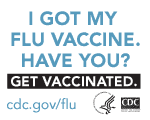Bats & Rabies
 Spotlight:
Spotlight:  Bats and Summer Camps Brochure (PDF 1362 KB, 3 pages)
Bats and Summer Camps Brochure (PDF 1362 KB, 3 pages)
Safety and risk management for exposures to bats in a camp setting.
Q & A about Rabies and Bats and Summer Camps
How to reduce the risk of rabies while at summer camp.
What is rabies and how do people get it?
Rabies is an infectious viral disease that affects the nervous system of humans and other mammals. People get rabies from the bite of an animal with rabies (a rabid animal). Any wild mammal, like a raccoon, skunk, fox, coyote, or bat, can have rabies and transmit it to people. It is also possible, but quite rare, that people may get rabies if infectious material from a rabid animal, such as saliva, gets directly into their eyes, nose, mouth, or a wound.
Because rabies is a fatal disease, the goal of public health is, first, to prevent human exposure to rabies by education and, second, to prevent the disease by anti-rabies treatment if exposure occurs. Tens of thousands of people are successfully treated each year after being bitten by an animal that may have rabies. A few people die of rabies each year in the United States, usually because they do not recognize the risk of rabies from the bite of a wild animal and do not seek medical advice.
Why Should I Learn About Bats and Rabies?
Most of the recent human rabies cases in the United States have been caused by rabies virus from bats. Awareness of the facts about bats and rabies can help people protect themselves, their families, and their pets. This information may also help clear up misunderstandings about bats.
When people think about bats, they often imagine things that are not true. Bats are not blind. They are neither rodents nor birds. They will not suck your blood -- and most do not have rabies. Bats play key roles in ecosystems around the globe, from rain forests to deserts, especially by eating insects, including agricultural pests. The best protection we can offer these unique mammals is to learn more about their habits and recognize the value of living safely with them.
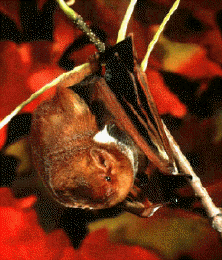
A male red bat rests for the day in a maple tree during fall migration south from Canada. Males are more brightly colored than females.

A hoary bat pauses in a hemlock tree. It is one of America's largest and most strikingly colored bats.
How Can I Tell If A Bat Has Rabies?
Rabies can be confirmed only in a laboratory. However, any bat that is active by day, is found in a place where bats are not usually seen (for example, in a room in your home or on the lawn), or is unable to fly, is far more likely than others to be rabid. Such bats are often the most easily approached. Therefore, it is best never to handle any bat.
What Should I Do If I Come In Contact With A Bat?
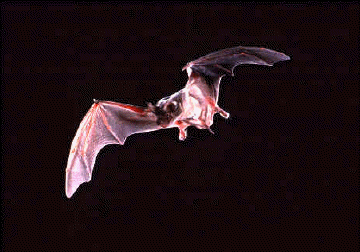
Mexican free-tailed bats are easily recognized by their tails, which extend well beyond the tail membrane. Its long, narrow wings are designed for speed and long-distance travel.
If you are bitten by a bat -- or if infectious material (such as saliva) from a bat gets into your eyes, nose, mouth, or a wound -- wash the affected area thoroughly and get medical advice immediately. Whenever possible, the bat should be captured and sent to a laboratory for rabies testing (see: How can I safely capture a bat in my home?).
People usually know when they have been bitten by a bat. However, because bats have small teeth which may leave marks that are not easily seen, there are situations in which you should seek medical advice even in the absence of an obvious bite wound. For example, if you awaken and find a bat in your room, see a bat in the room of an unattended child, or see a bat near a mentally impaired or intoxicated person, seek medical advice and have the bat tested.
People cannot get rabies just from seeing a bat in an attic, in a cave, or at a distance. In addition, people cannot get rabies from having contact with bat guano (feces), blood, or urine, or from touching a bat on its fur (even though bats should never be handled!).
What Should I Do If My Pet Is Exposed To A Bat?
If you think your pet or domestic animal has been bitten by a bat, contact a veterinarian or your health department for assistance immediately and have the bat tested for rabies. Remember to keep vaccinations current for cats, dogs, and other animals.
How Can I Keep Bats Out of My Home?
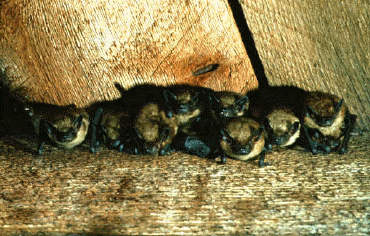
The big brown bat is found throughout most of the United States and Canada. It feeds principally on beetles.
Some bats live in buildings, and there may be no reason to evict them if there is little chance for contact with people. However, bats should always be prevented from entering rooms of your home. For assistance with"bat-proofing" your home, contact an animal-control or wildlife conservation agency. If you choose to do the "bat-proofing" yourself, here are some suggestions. Carefully examine your home for holes that might allow bats entry into your living quarters. Any openings larger than a quarter-inch by a half-inch should be caulked. Use window screens, chimney caps, and draft-guards beneath doors to attics, fill electrical and plumbing holes with stainless steel wool or caulking, and ensure that all doors to the outside close tightly.
Additional "bat-proofing" can prevent bats from roosting in attics or buildings by covering outside entry points. Observe where the bats exit at dusk and exclude them by loosely hanging clear plastic sheeting or bird netting over these areas. Bats can crawl out and leave, but cannot re-enter. After the bats have been excluded, the openings can be permanently sealed. For more information about "bat-proofing" your home, contact Bat Conservation International.
Things To Remember When "Bat-Proofing"

- During summer, many young bats are unable to fly. If you exclude adult bats during this time, the young may be trapped inside and die or make their way into living quarters. Thus, if possible, avoid exclusion from May through August.
- Most bats leave in the fall or winter to hibernate, so these are the best times to "bat-proof" your home.
How Can I Safely Capture A Bat In My Home?
If a bat is present in your home and you cannot rule out the possibility of exposure, leave the bat alone and contact an animal-control or public health agency for assistance. If professional help is unavailable, use precautions to capture the bat safely, as described below.
What you will need:
- leather work gloves (put them on)
- small box or coffee can
- piece of cardboard
- tape
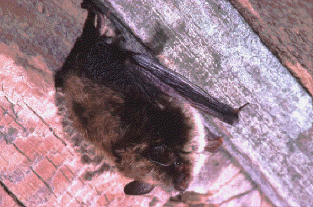
The little brown bat is one of America's most abundant and widespread species. It is often found roosting in attics or barns.
When the bat lands, approach it slowly, while wearing the gloves, and place the box or coffee can over it. Slide the cardboard under the container to trap the bat inside. Tape the cardboard to the container securely, and punch small holes in the cardboard, allowing the bat to breathe. Contact your health department or animal-control authority to make arrangements for rabies testing.
If you see a bat in your home and you are sure no human or pet exposure has occurred, confine the bat to a room by closing all doors and windows leading out of the room except those to the outside. The bat will probably leave soon. If not, it can be caught, as described, and released outdoors away from people and pets.
How Can Rabies Be Prevented?
- Teach children never to handle unfamiliar animals, wild or domestic, even if they appear friendly. "Love your own, leave other animals alone" is a good principle for children to learn.
- Wash any wound from an animal thoroughly with soap and water and seek medical attention immediately.
- Have all dead, sick, or easily captured bats tested for rabies if exposure to people or pets occurs.
- Prevent bats from entering living quarters or occupied spaces in homes, churches, schools, and other similar areas where they might contact people and pets.
- Be a responsible pet owner by keeping vaccinations current for all dogs, cats, and ferrets, keeping your cats and ferrets inside and your dogs under direct supervision, calling animal control to remove stray animals from your neighborhood, and consider having your pets spayed or neutered.
Case Study

Silver-haired bats often roost in tree cavities or in bark crevices on tree trunks, especially during migration. Their unique coloration makes them difficult to find. Most recent human rabies deaths have been due to a strain of rabies associated with this species.
In February 1995, the aunt of a 4-year-old girl was awakened by the sounds of a bat in the room where the child was sleeping. The child did not wake up until the bat was captured, killed, and discarded. The girl reported no bite, and no evidence of a bite wound was found when she was examined. One month later the child became sick and died of rabies. The dead bat was recovered from the yard and tested--it had rabies.
This case demonstrates several points:
- This child's infection with rabies was most likely the result of a bat bite. Children sleep heavily and may not awaken from the presence of a small bat. A bat bite can be superficial and not easily noticed.
- The bat was behaving abnormally. Instead of hiding, the bat was making unusual noises and was having difficulty flying. This strange behavior should have led to a strong suspicion of rabies.
- If the bat had been submitted for rabies testing, a positive test would have led to life-saving anti-rabies treatment.
Remember, in situations in which a bat is physically present and you cannot reasonably rule out having been bitten, safely capture the bat for rabies testing and seek medical attention immediately.
Are Bats Beneficial?
Yes. Worldwide, bats are a major predator of night-flying insects, including pests that cost farmers billions of dollars annually. Throughout the tropics, seed dispersal and pollination activities by bats are vital to rain forest survival. In addition, studies of bats have contributed to medical advances including the development of navigational aids for the blind. Unfortunately, many local populations of bats have been destroyed and many species are now endangered.
Where Can I Learn More About Bats?
Contact your state or local wildlife conservation agency or Bat Conservation International:
Bat Conservation International, Inc.
P O Box 162603
Austin, Texas 78716
www.batcon.org
To learn more about endangered bats and the Endangered Species Act, contact the US Fish and Wildlife Service:
U S Fish and Wildlife Service
Division of Endangered Species
4401 N. Fairfax Drive, Room 452
Arlington, Virginia 22203
www.fws.gov
Where Can I Learn More About Rabies
Contact your state or local health department or the Centers for Disease Control and Prevention:
Centers for Disease Control and Prevention
National Center for Infectious Diseases
Rabies Section MS G-33
1600 Clifton Road
Atlanta, Georgia 30333
www.cdc.gov/rabies
The photos that appear on this site were provided courtesy of Bat Conservation International, Inc. (BCI) and were used with permission. The use of these photos and the shared development of this brochure do not imply endorsement of BCI's views, services, or products by the Public Health Service or the U.S. Department of Health and Human Services.
Bats and Rabies: A Public Health Guide. Brochures designed for desktop printing (four PDF formats below)
 Bats and Rabies Brochure; full color (PDF – 5 pages)
Bats and Rabies Brochure; full color (PDF – 5 pages) Bats and Rabies Brochure; full color brochure (PDF – 2 pages)
Bats and Rabies Brochure; full color brochure (PDF – 2 pages) Bats and Rabies Brochure; full color 9.25" x 20" brochure (PDF – 2 pages)
Bats and Rabies Brochure; full color 9.25" x 20" brochure (PDF – 2 pages) Bats and Rabies Brochure; black & white brochure (PDF – 2 pages)
Bats and Rabies Brochure; black & white brochure (PDF – 2 pages)
* Links to non-Federal organizations found at this site are provided solely as a service to our users. These links do not constitute an endorsement of these organizations or their programs by CDC or the Federal Government, and none should be inferred. CDC is not responsible for the content of the individual organization Web pages found at these links.
![]() Please note: Some of these publications are available for download only as *.pdf files. These files require Adobe Acrobat Reader in order to be viewed. Please review the information on downloading and using Acrobat Reader software.
Please note: Some of these publications are available for download only as *.pdf files. These files require Adobe Acrobat Reader in order to be viewed. Please review the information on downloading and using Acrobat Reader software.
Page last reviewed: December 1, 2003
Content Source: National Center for Zoonotic, Vector-Borne, & Enteric Diseases (ZVED)

